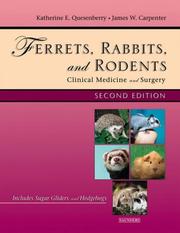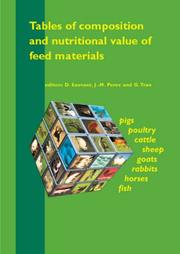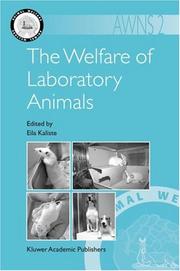| Listing 1 - 7 of 7 |
Sort by
|
Book
ISBN: 2901081630 Year: 2004 Volume: 75 Publisher: Toul : Société d'ethnozootechnie,
Abstract | Keywords | Export | Availability | Bookmark
 Loading...
Loading...Choose an application
- Reference Manager
- EndNote
- RefWorks (Direct export to RefWorks)
Rabbits --- Ethnozoology --- Lapins --- Ethnozoologie --- Congresses --- Congrès --- Congrès
Book

ISBN: 9782844443472 9782844443465 Year: 2004 Publisher: Dijon : Educagri,
Abstract | Keywords | Export | Availability | Bookmark
 Loading...
Loading...Choose an application
- Reference Manager
- EndNote
- RefWorks (Direct export to RefWorks)
domestic animals --- domestic animals --- Animal feeding --- Animal feeding --- rabbits --- rabbits --- Swine --- Swine --- poultry --- poultry --- horses --- horses --- Food additives --- Food additives --- Digestion --- Digestion
Book
Year: 2004 Publisher: [Place of publication not identified] Saunders
Abstract | Keywords | Export | Availability | Bookmark
 Loading...
Loading...Choose an application
- Reference Manager
- EndNote
- RefWorks (Direct export to RefWorks)

ISBN: 0721693776 9780721693774 Year: 2004 Publisher: St. Louis, Mo. Saunders
Abstract | Keywords | Export | Availability | Bookmark
 Loading...
Loading...Choose an application
- Reference Manager
- EndNote
- RefWorks (Direct export to RefWorks)
Ferret --- Rabbits --- Rodents --- Diseases. --- Surgery. --- Lagomorpha --- Mustelidae --- Mammals --- Vertebrates --- Carnivora --- Chordata --- Animals --- Eukaryota --- Organisms --- Ferrets --- Rodentia --- Health & Biological Sciences --- Veterinary Medicine --- Diseases --- Surgery --- Chinchilla Rabbits --- NZW Rabbits --- New Zealand White Rabbits --- Oryctolagus cuniculus --- Belgian Hare --- New Zealand Rabbits --- Rabbit, Domestic --- Chinchilla Rabbit --- Domestic Rabbit --- Domestic Rabbits --- Hare, Belgian --- NZW Rabbit --- New Zealand Rabbit --- Rabbit --- Rabbit, Chinchilla --- Rabbit, NZW --- Rabbit, New Zealand --- Rabbits, Chinchilla --- Rabbits, Domestic --- Rabbits, NZW --- Rabbits, New Zealand --- Zealand Rabbit, New --- Zealand Rabbits, New --- cuniculus, Oryctolagus --- Beavers --- Capybaras --- Castor Beaver --- Dipodidae --- Hydrochaeris --- Jerboas --- Beaver --- Capybara --- Hydrochaeri --- Jerboa --- Rodent --- Rodentias --- Domestic Polecats --- European Polecats --- Mustela putorius --- Mustela putorius furo --- Domestic Polecat --- Polecat, Domestic --- Polecats, Domestic --- Polecats, European --- Eucarya --- Eukarya --- Eukaryotes --- Eukaryotas --- Eukaryote --- Animalia --- Animal --- Metazoa --- Chordates --- Chordate --- Vertebrate --- Mammalia --- Mammal --- Badgers --- Gulo --- Martens --- Martes --- Martes zibellina --- Sables --- Weasels --- Wolverines --- Badger --- Gulos --- Marten --- Sable --- Weasel --- Wolverine --- Lagomorphs --- Leporidae --- Ochotonidae --- Ochotona --- Pikas --- Lagomorph --- Pika --- Domestic rabbit --- Rabbits as pets --- Domestic animals --- European rabbit --- Domestic ferret --- European ferret --- Mustela furo --- European polecat --- New Zealand White Rabbit --- European Polecat --- Polecat, European --- Ferret. --- Hedgehogs. --- Rabbits. --- Ferret - Diseases. --- Rabbits - Diseases. --- Rodents - Diseases. --- Ferret - Surgery. --- Rabbits - Surgery. --- Rodents - Surgery. --- Rodent diseases
Article
Abstract | Keywords | Export | Availability | Bookmark
 Loading...
Loading...Choose an application
- Reference Manager
- EndNote
- RefWorks (Direct export to RefWorks)
Under commercial rearing conditions, domestic turkeys are often aggressive towards "pen-mates", and this may lead to serious injuries or even death. We hypothesized that restricted space, as a consequence of high stocking density, might prevent the attacked bird from retreating from its opponent to avoid serious consequences from an encounter. This study examines the aggressive response in 10 groups of five familiar turkey toms, comparing behaviour to an unfamiliar conspecific that is introduced to two pens of different sizes. Groups were tested both in a small (2 m x 3 m) and in a large (6 m x 13 m) pen for 30 min. Aggressive interactions and distances between the newly introduced bird and test-group members, and additionally distances among test-group members, were recorded. In the small pen we observed significantly more aggressive pecks and threats to the introduced bird. In the large pen introduced birds kept a greater distance from the group than in the small pen. However, they did not make use of all of the available floor space in the large pen. The mean number of fights and chases per test was no different between the two pens. We conclude that the aggressive response of the group was reduced with an increase in floor space. To summarise, the present study shows that in small groups of turkeys, an increase in floor space reduces the number of aggressive pecks and threats aimed at an introduced unfamiliar conspecific. Additionally, we found evidence that there might be a critical distance below which retreating from an opponent is not successful in avoiding aggressive encounters. (C) 2004 Published by Elsevier B.V
Aggressive. --- Behaviour. --- Bird. --- Boxes. --- Consequences. --- Conspecific. --- Death. --- Density. --- Distance. --- Distances. --- Environmental enrichment. --- Fight. --- Floor space. --- Floor. --- Group. --- Housing. --- Increase. --- Injuries. --- Injurious pecking. --- Injury. --- Interaction. --- Interactions. --- Kept. --- Laying hens. --- Light-intensity. --- Male domestic turkeys. --- Male. --- Management. --- Pen. --- Performance. --- Poultry. --- Rabbit. --- Rabbits. --- Rearing. --- Response. --- Space. --- Stocking density. --- Switzerland. --- Test. --- Time-budgets. --- Time. --- Turkey. --- Turkeys. --- Welfare.


ISBN: 2738011705 9076998418 9789076998411 9782738011701 9086866689 2738011586 9782738011589 Year: 2004 Publisher: Wageningen : Paris : Wageningen Academic Publishers ; INRA,
Abstract | Keywords | Export | Availability | Bookmark
 Loading...
Loading...Choose an application
- Reference Manager
- EndNote
- RefWorks (Direct export to RefWorks)
Feeds --- Animal nutrition --- Animal Feed --- Animal Nutritional Physiological Phenomena. --- Animals, Domestic. --- Composition --- analysis --- statistics and numerical data --- Animal feeding. --- Animals -- Food. --- 636.085.1 --- Composition of feedstuffs --- 636.085.1 Composition of feedstuffs --- Animals --- Food. --- Chemical composition --- feed composition --- food composition --- Nutritive value --- animal husbandry --- poultry --- Sheep --- Swine --- Goats --- rabbits --- Feed industry --- Fish feeding --- Animal feeding --- Feed composition and quality. --- Animal nutrition. --- Animal feed. --- Nutritive Value. --- Animal Nutritional Physiological Phenomena --- Animals, Domestic --- Nutritive Value --- analysis.

ISBN: 9781402022708 1402022700 9781402022715 9781402061363 1402061366 9786610852390 1280852399 1402022719 Year: 2004 Volume: 2 Publisher: Dordrecht ; Boston : Kluwer Academic Publishers,
Abstract | Keywords | Export | Availability | Bookmark
 Loading...
Loading...Choose an application
- Reference Manager
- EndNote
- RefWorks (Direct export to RefWorks)
Animal welfare is attracting increasing interest worldwide, but particularly from those in developed countries, who now have the knowledge and resources to be able to offer the b est management systems for their farm animals, as well as potentially being able to offer plentiful resources for companion, zoo and laboratory animals. The increased attention given to animal welfare in the West derives la rgely from the fact that the relentless pursuit of financial reward and efficiency has lead to the development of intensive animal production systems that offend the conscience of many consumers in those countries. In devel oping countries, human survival is still a daily uncertainty, so that provision fo r animal welfare has to be balanced against human welfare. Welfare is usua lly provided for only if it supports the output of the animal, be it food, work, clothing, sport or companionship. In reality there are resources for all if they are properly husbanded in both developing and developed countries. The inequitable division of the world’s riches creates physical and psychological poverty for humans and animals alike in all sectors of the world. Liv estock are the world’s biggest land user (FAO, 2002) and the population, particularly of monogastric animals, is increasing rapidly to meet the need of an expanding human population. Populations of animals managed by humans are therefore increasing worldwide, so there is the tendency to allocate fewer resources to each one.
Animal Welfare. --- Animals, Laboratory. --- Animal welfare. --- Laboratory animals. --- Animaux --- Animaux de laboratoire --- Protection --- Agriculture. --- Laboratory animals --- Animal welfare --- Animal Welfare --- Animals, Laboratory --- Animal Population Groups --- Social Control, Formal --- Sociology --- Animals --- Social Sciences --- Eukaryota --- Anthropology, Education, Sociology and Social Phenomena --- Organisms --- Zoology - General --- Social Welfare & Social Work - General --- Animal Sciences --- Zoology --- Agriculture --- Social Welfare & Social Work --- Health & Biological Sciences --- Earth & Environmental Sciences --- Animals, Experimental --- Animals in research --- Experimental animals --- Lab animals --- Animal culture --- Laboratory organisms --- Working animals --- Animal experimentation --- Abuse of animals --- Animal cruelty --- Animals, Cruelty to --- Animals, Protection of --- Animals, Treatment of --- Cruelty to animals --- Humane treatment of animals --- Kindness to animals --- Mistreatment of animals --- Neglect of animals --- Prevention of cruelty to animals --- Protection of animals --- Treatment of animals --- Welfare, Animal --- Abuse of --- Social aspects --- Zoology. --- Animal genetics. --- Animal behavior. --- Animal physiology. --- Veterinary medicine. --- Animal Genetics and Genomics. --- Behavioral Sciences. --- Animal Physiology. --- Veterinary Medicine/Veterinary Science. --- Farriery --- Large animal medicine --- Large animal veterinary medicine --- Livestock medicine --- Veterinary science --- Medicine --- Animal health --- Domestic animals --- Livestock --- Animal physiology --- Biology --- Anatomy --- Animals, Habits and behavior of --- Behavior, Animal --- Ethology --- Animal psychology --- Ethologists --- Psychology, Comparative --- Genetics --- Natural history --- Diseases --- Losses --- Physiology --- Behavior --- Behavioral sciences. --- Animal Husbandry. --- Dogs. --- Rabbits. --- Animal Husbandry --- Dogs --- Rabbits --- Primates --- Rodents --- Swine
| Listing 1 - 7 of 7 |
Sort by
|

 Search
Search Feedback
Feedback About UniCat
About UniCat  Help
Help News
News